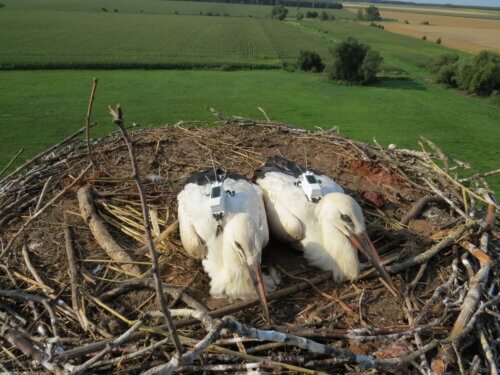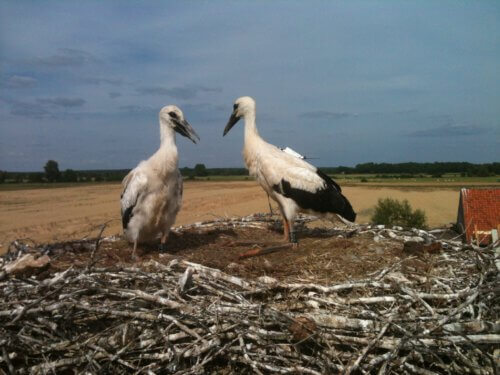The international research was carried out on young white storks (Ciconia ciconia). Prof. Ran Natan, one of the leaders of the study, on one of the important findings discovered in the study: "Previous studies suggested that individuals with a proactive nature - active, bolder and more aggressive - have a higher chance of surviving under certain conditions. The results of our study support this hypothesis"

Survival of most animals in the wild is low especially at the beginning of their lives. Who are the survivors and what characterizes them is a central question in ecology, but also one that is difficult to answer due to the difficulty in collecting suitable data from wild animals. It is known from previous studies that the early period of life has a decisive and long-term effect on the survival of the individual later in life. The weather conditions, the habitat, the quality of parental care at the beginning of life work in parallel with hereditary traits and together affect the body structure, skills and even the character of the offspring, and can significantly improve their survival in the future. Fatter chicks or those that hatched earlier in the season, for example, are known to have better survival chances, probably due to their competitive advantage over thin chicks or those that hatched late. But what about the behavior? Can differences in behavior at an early age predict who will be the outstanding survivors later in life and who will not survive?
In migratory birds, fledglings (young birds that have just hatched from the nest) have a short period of a few weeks before they embark on their first migration of their lives - a physically difficult and dangerous ordeal that many of them will not survive. The activity of the young during the period between flowering and migration is extremely important for learning the necessary skills of flight and foraging, so it can be assumed that differences between individuals in their activity during this period can predict which of them will survive in the future. This issue was the focus of a new study that focused on migratory birds and was conducted at the Movement Ecology Laboratory headed by Prof. Ran Natan as part of Dr. Shai Rotich's doctoral thesis at the Institute of Life Sciences at the Hebrew University, and included nine other researchers from the laboratory and the German University of Potsdam and the Max Planck Institute for Animal Behavior. A scientific article describing this work was published a few days ago (January 13) in the journal "Proceedings of the royal society B". "Migratory birds are an excellent model for examining the relationship between behavioral differences in early life stages and subsequent survival," the article states.

As part of the study, small tags transmitting GPS data (every 5 minutes) and body acceleration (every 15 seconds) were attached to 103 white storks (Ciconia ciconia) young about two weeks before they bloom from the nest. This work was carried out in Germany over four years, between 2011 and 2014, where the Hasids nest in settlements and agricultural areas. The migration of the white heron has been studied extensively in Israel and around the world, and this species is a symbol of bird migration since the days of the prophet Jeremiah and an excellent research model for examining the relationship between activity at the beginning of life before migration (in Germany) and survival during the first year of life (from Europe to Africa and back, mostly through Israel). The GPS data provided information on the movement of the individuals and the body acceleration data made it possible to quantify the level of activity and distinguish between different behaviors (walking, pecking food, hovering or flapping, standing, sitting and cleaning feathers) with a high level of accuracy. The condition of the eggs and chicks in the nests was recorded using a drone. This is how data on body weight, hatching and migration dates, the number of siblings and the pair of chicks - found as predictors of survival in previous studies - were collected. The survival estimate was made according to the position and body acceleration data of the transmitted birds, which in many cases allowed physical arrival at the site to verify that it was indeed a mortal event.
The research findings showed that young storks that were more active in the nest before hatching than from it, were also more active in the subsequent period after hatching from the nest to migration, and their survival later in migration and during the first year of their life was higher. In order to focus on the influence of Hasidic activity at the beginning of life, other factors such as weather conditions (which were different in the four years of the study) were taken into account in the data analysis and it was found that differences in the level of Hasidic activity before the start of their migration explain a significant part of the variation in their survival later on. In addition, it was found that after the fledging of the young from the nest, the level of their daily activity increased gradually, a trend that probably reflects the rate of motor development and spatial learning. The surviving-excellent Hasids were those who showed a high level of activity and a high rate of daily improvement of the level of activity in the period before leaving for migration.
Moreover, as explained in the article, the surveillance data revealed individual quality differences of the birds that may affect their survival later in their lives. Prof. Natan explains: "Our data showed that beyond the influence of experience, body weight, differences in conditions between years and parental investment, the level of activity characterizes the quality of the individual. Differences in the quality of the individual can arise, for example, from differences in the physiological or character traits of each bird. The recognition that animals have a distinct character is supported by thousands of scientific works in recent years. A relevant example for our purposes is a study on White Hasids in Spain that suggested that a proactive character - individuals that are active, bold and more aggressive - is correlated with higher survival, at least under certain conditions. The results of our study support this hypothesis. That's why we suggested, with the necessary caution, that a high level of activity may indicate a proactive nature that gives the young individual an advantage in survival as we found in this study."
Another major factor studied is the length of time between hatching from the nest and the start of migration, which is critical for training and preparation for migration. The researchers hypothesized that individuals that migrated after a longer "training period" would have a higher survival rate. The fascinating findings showed that when the duration of the training period is short, only about a week, the chances of survival are indeed small, probably because this short time is not enough to acquire necessary experience and skills. When the duration of the training period is two or three weeks, the chances of survival have clearly increased. However, contrary to what was assumed, when the training period is particularly long, about a month or even more, the chances of survival dropped to low values. The explanation for this surprising finding emerged from additional data of the data, as Prof. Natan explains: "We found that the daily activity improvement rate of these individuals is low. These are probably individuals whose rate of development or learning is slow, therefore the departure for migration is excessively delayed and their survival in the continuation of the migration is low".
In conclusion, the research findings emphasize that a short period at the beginning of the birds' lives, especially a few weeks after they hatch from the nest, is of critical importance in determining their chances of survival during migration later in their lives. This study also emphasizes the importance of examining the differences in individual traits, such as character traits, which can be studied not only through controlled laboratory experiments but also in wild animals in their natural environment using data from telemetry tracking transmitters, and with their help predict the chances of survival. This study is one of the first to demonstrate the use of tracking data to study the behavior patterns of free wild animals in their natural environment, and has important implications for the interface, nature conservation and the success of bird return programs to their natural habitat.
For further reading, a scientific article is attached
More of the topic in Hayadan:
